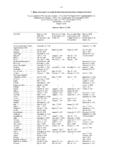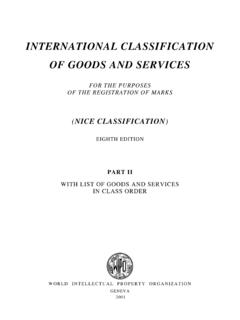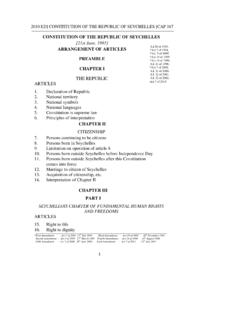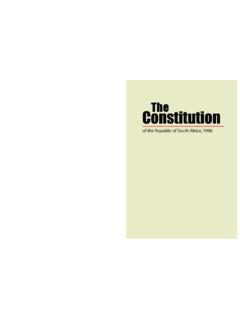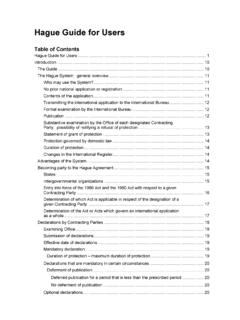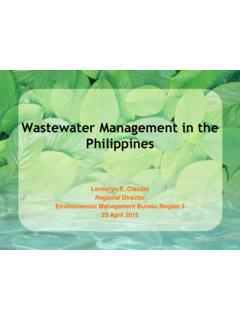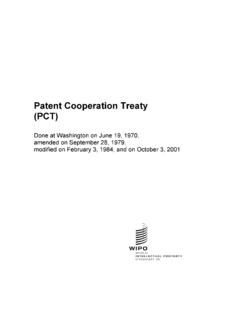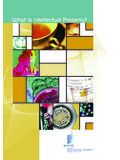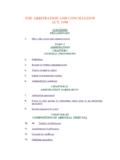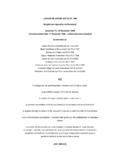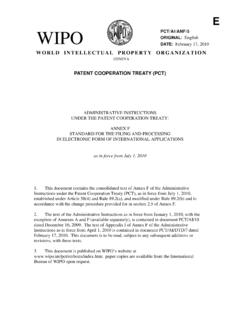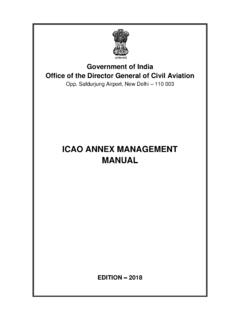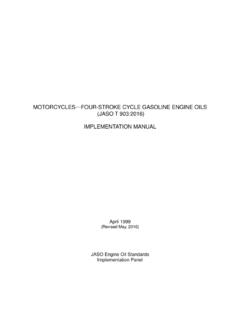Transcription of ST.96 - Recommendation for the processing of …
1 HANDBOOK ON industrial property information AND DOCUMENTATION Ref.: standards - page: en / 03-96-01 Date: June 2020 STANDARD Version Recommendation FOR THE processing OF INTELLECTUAL property information USING XML (EXTENSIBLE MARKUP LANGUAGE) Revision approved by the XML4IP Task Force of the Committee of WIPO standards (CWS) on June 1, 2020 Table of Contents STANDARD .. 1 WIPO STANDARD .. 2 INTRODUCTION .. 2 DEFINITIONS AND TERMINOLOGY .. 2 SCOPE OF THE STANDARD .. 3 REQUIREMENTS OF THE STANDARD .. 4 General .. 4 XML schema structure .. 4 Identification of types, elements and attributes: Namespace .. 4 Naming office-specific schemas .. 4 External entities .. 5 Industry-standard schemas .. 5 REFERENCES .. 5 ANNEXES The Annexes are available at: Annex I XML Design Rules and Conventions Annex II IP Data Dictionary Annex III IP XML Schemas Annex IV XML Schema Technical Specification Annex V Schema Implementation Rules and Guidelines Annex VI Transformation Rules and Guidelines Annex VII Example XML Instances HANDBOOK ON industrial property information AND DOCUMENTATION Ref.
2 : standards - page: en / 03-96-01 Date: June 2020 WIPO STANDARD Version Recommendation FOR THE processing OF INTELLECTUAL property information USING XML (EXTENSIBLE MARKUP LANGUAGE) Revision approved by the XML4IP Task Force of the Committee on WIPO standards (CWS) on June 1, 2020 INTRODUCTION 1. This Standard recommends the XML (eXtensible Markup Language) resources to be used for filing, publication, processing , and exchange of information for all types of intellectual property (IP), , patents, trademarks, industrial designs, geographical indications and copyright. 2. This Standard recommends only the W3C XML schema language. For further information about the W3C (World Wide Web Consortium), see 3. This Standard comprises a set of recommendations, including rules and conventions for designing XML resources, and a common vocabulary for the IP community to exchange IP information in XML.
3 4. This Standard is intended to: (a) enhance interoperability amongst intellectual property offices (IPOs); (b) improve the harmonization among all types of IP information ; (c) facilitate data compatibility, in particular, data transformability with WIPO standards , and ; (d) improve the consistency of IP information ; and (e) promote a common practice of implementation of XML schemas. 5. This Standard refers to other WIPO standards and industry standards including ISO standards . Further details are available in the References Section below. DEFINITIONS AND TERMINOLOGY 6. The term XML resources is intended to refer to any of the components used to create and operate an XML implementation according to this Standard. 7. The term XML schema is a language for describing the structure and constraining the contents of XML documents. 8. The keywords MUST, MUST NOT, SHALL, SHOULD, SHOULD NOT, and MAY, when they appear in this Standard, are to be interpreted as described below.
4 Non-capitalized forms of these words are used in the regular English sense. The definition of keywords is based on the Request for Comments 2119 - Key words for use in RFCs to Indicate Requirement Levels issued by the Internet Engineering Task Force. (a) MUST: This word, or the terms REQUIRED or SHALL , means that the definition is an absolute requirement of the specification; (b) MUST NOT: This phrase, or the phrase SHALL NOT , means that the definition is an absolute prohibition of the specification; (c) SHOULD: This word, or the adjective RECOMMENDED , means that there may exist valid reasons in particular circumstances to ignore a particular item, but the full implications must be understood and carefully weighed before choosing a different course; (d) SHOULD NOT: This phrase, or the phrase NOT RECOMMENDED , means that there may exist valid reasons in particular circumstances when the particular behavior is acceptable or even useful, but the full implications should be understood and the case carefully weighed before implementing any behavior described with this label.
5 And HANDBOOK ON industrial property information AND DOCUMENTATION Ref.: standards - page: en / 03-96-01 Date: June 2020 (e) MAY: This word, or the adjective OPTIONAL , means that an item is truly optional. An implementation that does not include a particular option MUST be prepared to interoperate with another implementation that does include the option, though perhaps with reduced functionality. In the same vein, an implementation that does include a particular option MUST be prepared to interoperate with another implementation that does not include the option (except, of course, for the feature the option provides). 9. For the purposes of this Standard, the following definitions are given: (a) the expression patent includes such industrial property rights as patents for inventions, plant patents, design patents, inventors certificates, utility certificates, utility models, patents of addition, inventors certificates of addition and utility certificates of addition; (b) the expression trademark means trademark, service mark or another type of distinguishing representation of mark according to the definition of the mark in the legislation concerned, including but not limited to collective mark, certification mark or guarantee mark; (c) the expression industrial design includes two-dimensional and three-dimensional features of shape and surface of objects, and thus covers both concepts of designs and models where a distinction is made between the former and the latter.
6 The term industrial designs does not include design patents; (d) the expression geographical indication means a sign used on products that have a specific geographical origin and possess qualities or a reputation that are due to that origin; and (e) the expression copyright includes rights that creators have over their literary and artistic works and the expression copyright orphan work includes works that are protected by copyright, but the author cannot be identified or found. 10. Markup is defined as text that is added to the content of a document and that describes the structure and other attributes of the document in a non-system-specific manner, independently of any processing that MAY be performed on it. SCOPE OF THE STANDARD 11. This Standard is aimed at providing guidance to national, regional and international authorities who, on the basis of national intellectual property laws or international intellectual property conventions, deal with data and documents of patent, trademark, industrial design, geographical indication and/or copyright orphan work.
7 12. This Standard is intended to provide XML resources to be used for filing, publication, processing , and exchange of IP data and information . 13. It is understood that this Standard cannot possibly include all XML schemas required by all IPOs. Instead, this Standard provides guidance for IPOs to implement office-specific schemas and data exchange among IPOs by using XML resources defined in this Standard. 14. This Standard specifies: (a) the XML Design Rules and Conventions (DRCs) for IP data, , Annex I, which provides a comprehensive set of design rules and conventions for the creation of XML schemas and instances used for all types of IP information ; (b) the Data Dictionary, , Annex II, which is a data dictionary for IP information . It is intended to define data entities used for filing, processing , publication, and exchange of IP data and information ; (c) the XML Schemas, , Annex III, which is the set of XML schemas for components defined in Annex II.
8 The XML schemas are intended to be used for inter-office communication and reused for office implementation; (d) the Schema Technical Specification, , Annex IV, which provides technical documentation and details on the XML Schemas specified in Annex III; (e) the Schema Implementation Rules and Guidelines, , Annex V, which provides guidance for customization of XML Schemas defined in Annex III to fit a specific business requirement of an IPO; (f) the Transformation Rules and Guidelines, , Annex VI, which provides guidance for transformation between XML instances conforming to this Standard and XML instances validated against WIPO standards , or ; and (g) the Example XML Instances, , Annex VII, which provides example XML instances. HANDBOOK ON industrial property information AND DOCUMENTATION Ref.: standards - page: en / 03-96-01 Date: June 2020 REQUIREMENTS OF THE STANDARD General 15.
9 The XML DRCs, , Annex I, is the foundation of this Standard. 16. All elements, attributes and enumeration values of this Standard MUST be listed in the IP Data Dictionary, , Annex II. 17. Conformance is important in the context of data exchange. conformance at the instance and schema level means that there are no constraint violations when validating an instance against an Schema which is defined in Annex III. An conformant XML instance is an instance that validates against an Schema. An XML schema is an conformant schema if it sustains constraints expressed by an Schema. For data exchange, an XML document instance MUST be an conformant XML instance. 18. Every version of Annex III MUST be released in its entirety including updated and unmodified XML Schema components. 19. Implementation of XML schemas that are compatible with this Standard MUST be carried out according to the DRCs, , Annex I, and SHOULD reuse XML schemas defined in Annex III, following the Schema Implementation Rules and Guidelines, , Annex V.
10 20. Maintaining compatibility with existing documents using WIPO standards , and is one of the primary concerns for this Standard. Therefore, this Standard seeks the necessary degree of compatibility and convertibility with WIPO standards , , and in order to ensure that data can be processed satisfactorily for the business needs of IPOs and IP information suppliers. While an attempt has been made to incorporate improvements over , , and , not all national requirements were captured. Consequently, this Standard leaves the transformation of any remaining national elements as the responsibility of Offices which have extended , , and 21. In this Standard, many XML schemas use the model of choice between structured format and unstructured format at the same time. In all cases, structured text is preferred to unstructured text or images. XML schema structure 22.
